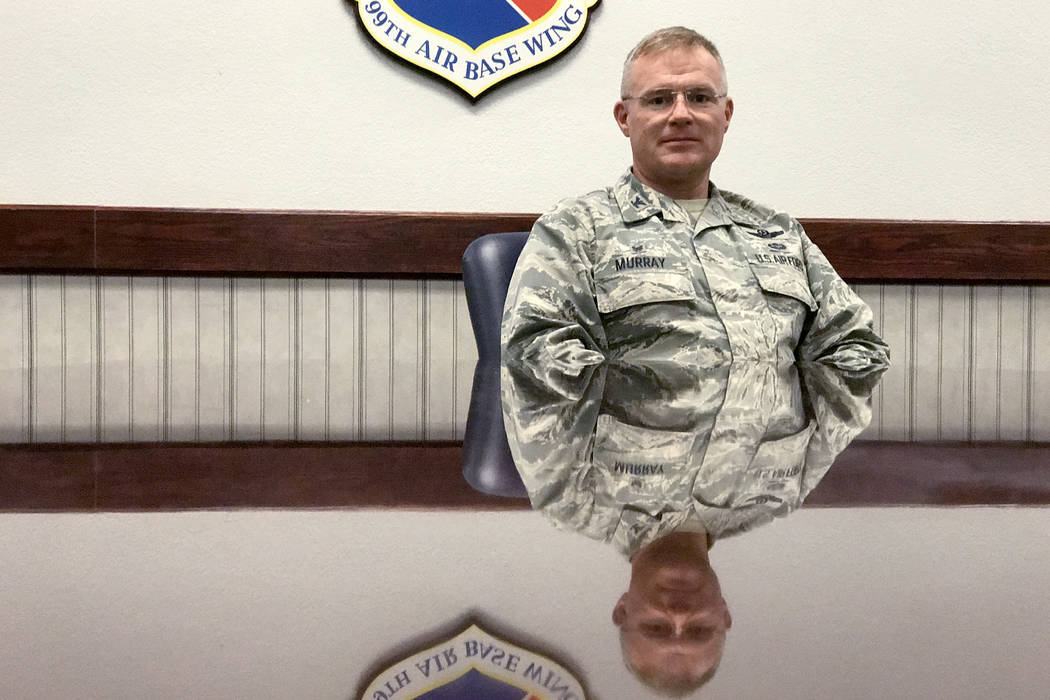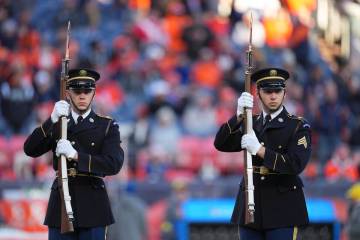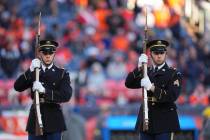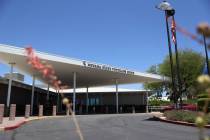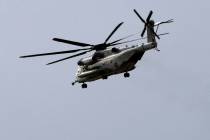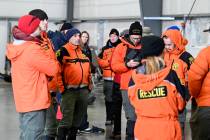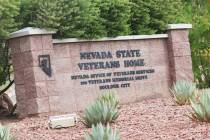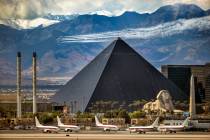Nellis commander keeps Air Force bases humming
Col. Paul J. Murray doesn’t have the household name recognition of Las Vegas Mayor Carolyn Goodman or her more famous and flamboyant predecessor husband, Oscar Goodman.
But when it comes to mayoral clout in Southern Nevada, Murray packs a wallop. As commander of the 99th Air Base Wing at Nellis Air Force Base, the 44-year-old oversees an installation that pumps $5.5 billion into the local economy and employs roughly 20,000 military and civilian personnel, who in turn support an equal number of family members.
“I am the ‘mayor’ of Nellis, Creech and the Nevada Test and Training Range,” Murray, an F-16 pilot, combat veteran and Air Force Academy graduate, said Thursday in his first sit-down interview with the Las Vegas Review-Journal since taking the reins of the 99th Wing in July.
“We are the stewards of over one-third of the land that the Air Force owns around the world,” he said. “What we do here is absolutely critical to our national security.”
While his fellow commanders — Brig. Gen. Jeannie Leavitt of the 57th Wing at Nellis and Col. Case Cunningham of the 432nd Wing at Creech — are respectively in charge of flying and testing the Air Force’s high-tech warplanes and remotely piloted aircraft, it’s Murray’s job to make sure they have what they need to make air combat exercises and overseas drone operations happen.
“We enable their success by being the mayor,” he said, referring to his staff. “The mayor doesn’t run the corner coffee shop, but he makes sure the corner coffee shop gets power, water and it’s protected by police and fire.”
Murray said that, with both Las Vegas and the Nellis base growing, he also needs to be a forward-looking mayor.
“We have a lot more concerns, not just about noise but the accident potential,” he said.
Air power galore
Murray is quick to note that Creech Air Force Base, 45 miles northwest of Las Vegas at Indian Springs, controls two-thirds of all remotely piloted Predator and Reaper drone operations around the world.
Because of the high demand for reconnaissance and air strike capabilities in the global war on terrorism, Murray predicts personnel at Creech will “grow over the next five to seven years by as much as a third” over the current 3,000, counting ground-support troops. That’s because commanders have urged the Pentagon to allow for a rotation of air crews to give “dwell normalization,” or down time, from combat duty.
The Nellis base and the 2.9 million-acre training range north of the Las Vegas Valley, with 12,000 square miles of dedicated air space, also will be the proving ground for new aircraft in the coming years. That includes the B-21 Raider long-range strike bomber and the “CRH,” or combat rescue helicopter.
“Every new airplane that the Air Force puts out comes here first,” Murray said.
Currently, as many as 14 Air Force F-35 Lightning II joint strike fighters fly to the range routinely from Nellis. Most — 11 — are operated by the 422nd Test and Evaluation Squadron at Nellis. But three are in use by the Air Force Weapons School for graduate-level “Top Gun” training.
Nellis received its first F-35 Lightning II in January 2015 and is slated to have 36 for testing and training by 2020.
The F-35A has a 25 mm cannon and can fly at one-and-a-half times the speed of sound, fire air-to-air missiles and drop GPS- and laser-guided bombs. Cameras on the aircraft give pilots a 360-degree view on their helmet visors.
In January, the F-35A flew for first time in tandem with the nation’s other stealth air-superiority jet, the F-22 Raptor, and more than 80 other warplanes and support aircraft in a Red Flag air combat exercise over the training range.
Cybersecurity
Murray said the weapons school doesn’t just produce doctorate-level fighter pilots. It’s also where Air Force personnel go to learn about cyberwarfare tactics and space-based defense architecture.
In layman’s terms, the cyberwarfare tactics mean “deliberately disrupting networks or internet-related systems,” he said. “Not just computers but things connected to the internet that control a power plant or a dam.”
Offensive cyberwarfare operations involve attacking computer networks to make them break down or shut down “or do something you want them to do,” he said. “And the defensive cyber operations are of course protecting all that stuff.”
He said entire squadrons — hundreds of people — are dedicated to both offensive and defensive tactics. As an example, he cited “figuring out how, if our nation decided, we would take down the electrical grid in North Korea.”
“That’s their job every day to find those vulnerabilities of our enemy and be prepared to — when directed by the president — execute some type of hack against it,” Murray said.
The critical nature of those missions gives the Air Force “mayor” of Southern Nevada confidence that Nellis, Creech and the sprawling training range will largely be spared in the event of any base closures or spending cutbacks.
Contact Keith Rogers at krogers@reviewjournal.com or 702-383-0308. Follow @KeithRogers2 on Twitter.
Serving Southern Nevada
Air Force economic impacts from Nellis and Creech bases and the Nevada Test and Training Range totaled $5.5 billion in 2015, the most recent year for which figures are available. Here's the breakdown:
— $1.134 billion of total payroll, covering 13,271 active duty, reserve, Air National Guard and civilian personnel
— $735.4 million of retiree benefits
— $3.4 billion in contracts, construction and base expenditures
— $242.6 million from 5,783 indirect jobs
Source: 99th Air Base Wing



